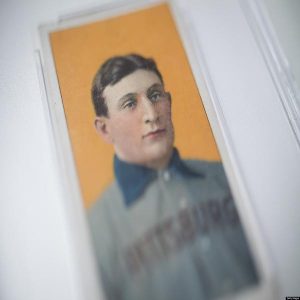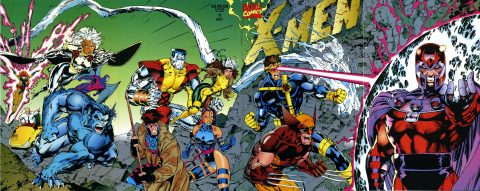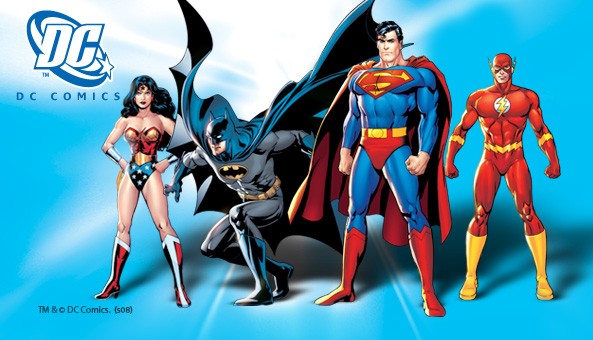
I heard the complaints of the older customers – those in their twenties – who griped that the industry had ‘sold out’ and complained bitterly that books weren’t being made for them anymore … everyone from the comic book shop owner to the group gathered around the cash register each Wednesday afternoon would solemnly agree with heads bowed and mournful voices.
The nineties are a decade that receives a lot of flack among comic book collectors. A lot of complaints justified. The nineties were a period of industry upheaval. Between 1990 and 1993 no less then 24 new comic book publishers were flooding the market with hundreds of titles and by 1996 all but a handful shuttered their doors. Quality control went out the window in favor of quantity in an attempt to capitalize on a classic bubble market that emerged. Marvel nearly went bankrupt. Both Marvel and DC were killing off legacy characters and replacing them with new and more “EXTREME” versions. Guy Gardner: Warrior anyone? It was an era when comic book companies realized that art moved more books then narrative and the quality of many stories suffered accordingly.
The cumulative impact of all of these factors have created a lingering sense that this was a decade when comic book publishers were blinded by financial greed and then self-inflicted distress by a saturated market place. The siren call of Hollywood was beckoning as well. The Batman movie franchise, which blew the doors off what a comic book movie could be, was just beginning in 1992. Jeff Loeb – a television writer – was brought into DC Comics and given one of the two keys to the kingdom when tasked to write Batman, much to the chagrin of life long employees who had been putting in their time and working up the comic companies archaic creative ladders. Marvel was selling its movie production rights to properties such as Spiderman, the X-Men, and Fantastic Four among others just to keep the lights on.
In reality the comic book industry was responding to changing market conditions brought on by a flurry of unprecedented speculation. The comic collecting craze of the early nineties was a text book case of bubble economics. It came crashing into an industry that was unprepared for it but recognized that it was time to make hay while the sun was shining. Millions of people suddenly started entering comic books shops in the early 1990’s and just as quickly stopped. The years between 1992 and 1996 saw sales reach unimaginable sums, print runs from all companies combined reached into the millions to satisfy consumer demand, and the publishing houses tried to pump every dollar they could out of it with foil and die cut collector’s issues.
For people like myself who were just entering the world of comic book  collecting in 1992 at the tender age of twelve, the books lining the shelves of my local comic book shop in a tiny Nova Scotian town offered a smorgasbord for the imagination. To me the books were exciting, they jumped off the shelves in ways that made the older comic books I had seen in the small collections my friends had amassed look stale and boring by comparison. The narratives weren’t always great – or even good sometimes – but to a twelve year old it was streets ahead better then the overwrought exposition that is a hallmark of comic books printed in the 1980’s and earlier.
collecting in 1992 at the tender age of twelve, the books lining the shelves of my local comic book shop in a tiny Nova Scotian town offered a smorgasbord for the imagination. To me the books were exciting, they jumped off the shelves in ways that made the older comic books I had seen in the small collections my friends had amassed look stale and boring by comparison. The narratives weren’t always great – or even good sometimes – but to a twelve year old it was streets ahead better then the overwrought exposition that is a hallmark of comic books printed in the 1980’s and earlier.
I heard the complaints of the older customers – those in their twenties – who griped that the industry had ‘sold out’ and complained bitterly that books weren’t being made for them anymore. There was a sense that the big two comic books publishers had turned their backs on them and the community of collectors that had nurtured them for nearly five decades. ‘Everyone is trying to retire on these things. It’s becoming just like the hockey card market. Speculation is killing comic books!’ To which everyone from the comic book shop owner to the group gathered around the cash register each Wednesday afternoon would solemnly agree with heads bowed and mournful voices.
It became a solemn credo spoken by those who were witnessing the death of a community and a hobby they no longer recognized but remembered fondly.
Even before the Internet comic book fan boys (and they were almost entirely male until the 2000s when publishers began to view female readers as a possible market) could be dramatic in the extreme. Jeff Smith, owner of The Comic Hunter which has locations in Moncton, New Brunswick and Charlottetown, Prince Edward Island, opened his first shop in 1989. He remembers these customers but is quick to point out “There have always been those guys in shops. The reason comics still exist is they adapt to the times.”
But still, there was something to it. The number of local comic shops exploded between 1989 and 1992. Consumer demand would prove short lived however and the massive print runs would prove to be unsustainable, ultimately leading directly to the collapse of thousands of local comic shops in the United States and Canada. The wild speculation that inflated prices disappeared and collectors witnessed their prized books become worthless over night. By the time the carnage was over the comic book industry was showing signs of being rode hard and put away wet.
While people focus on the symptoms of what made nineties comics ‘bad’, the disease that caused all this was pure economics. A bubble economy fueled by speculative mania whipped through our hobby, nearly killed it and left it reeling for years. Recovery only came in the 2010’s when film and television breathed new awareness of our beloved heroes, but has also brought another wave of market speculation with it, albeit a less potent form this time around.
The Speculation Boom.
What caused this crazy boom in comic book sales and speculation? Most people attribute or place the blame squarely on Superman #75 – the issue in which Superman dies at the hands of the monster Doomsday – but that issue is only part of the story. What most people don’t know, or have forgotten, is that while Superman #75 served as a gateway into comics for the masses, it wasn’t the cause of the comic book collecting bubble. No was it the singular spark that encouraged the various questionable decisions the comic book publishers made in an attempt to capitalize on that bubble. Did they feed into it? Oh, hell yeah they did, but it was a complex combination of economic principles that allowed a bubble market to be created in the first place.
It may be some consolation for true collectors to note that the root of the comic book bubble didn’t actually start with the comic book industry. The insidious disease of speculation began in the mid-1980s with baseball cards in the United States, and would eventually infect our beloved hobby. The sports card collecting frenzy made its way north of the boarder by late 1980s although it was hockey cards that drove our bubble because, well, it’s Canada.
 The history is fairly straightforward.
The history is fairly straightforward.
In the early 1980’s baseball card collectors were starting to realize that the little sheets of cardboard they had squirreled away as children, and were now re-discovering, had become a rare commodity.
Having been produced as a way to sell and cross-promote chewing gum and Major League Baseball the original runs of cards weren’t mass produced. There was no collector’s market to serve at this point, and there wasn’t any intention of creating one at the time. Baseball cards were merely a way to sell gum and baseball to kids. Over the years people tossed these cards in the garbage as no one in their right mind would have thought tiny sheets of cardboard could ever be worth money, thus reducing already small production runs to even smaller totals.
In Canada, the exact same thing happened with hockey cards printed in the 40’s, ‘50’s, and ‘60’s.
In both the United States and Canada there was a small group of people who made collecting these cards a hobby and didn’t part with them. By the mid-1980’s baseball card collectors in the United States began touring the country, renting rooms in local hotels and putting ads in local newspapers telling people where they were and that they were paying cash for their cards. Collectors were able to buy vast numbers of cards for peanuts. One of these collectors and traveling buyers was a statistician named James Becket who began polling his fellow collectors on the prices they were paying for cards. He compiled the data, produced the hobbies definitive collector’s price guide, and in the process birthed a market. The New York Times began to take notice when baseballs cards began appearing in auction houses like Sotheby’s and Christies. Between 1985 and 1991 the holy grail of baseball cards a 1909 Honus Wagner increased in value from $25,000 to a mind boggling $451,000 dollars when it was won at auction.
The 1991 auction was won by Canadian hockey God Wayne Gretzky. This happens to be when most Canadians first caught wind of the fact they might have ridiculously valuable hockey cards stuffed in the back of their attics. Thus the Canadian collector’s bubble was birthed. Go figure, it took a hockey player to buy a baseball card for us north of the forty-ninth parallel to take notice.
Bubble Markets Explained Super Quick.
Economists that study bubble markets have identified three characteristics that are common among them all. The first condition for a bubble market to begin its life is a burst of enthusiasm based on real returns on investment. The scarcity of a commodity determines its value and if that commodity is scarce enough to generate a real return people will begin to enter that market looking to profit.
As more people enter the market awareness increases. Usually its through word of mouth and through investors specialize in this sort of thing. As awareness becomes more mainstream the mass media will latch on and report it which adds fuel to the fire and brings more people into the market creating liquidity. The more people who enter it the more liquidity allowing initial investors an opportunity to flip their commodities and make a quick and normally inflated profit.
 Finally, the influx of people and the ever increasing liquidity of a bubble market will place pressure on the supply side of the matrix demanding more product for newcomers to buy. Not everyone will be able to afford to participate in the high end of the bubble economy but demand can still be met and fueled by creating tiers in the market to cater to different incomes. This ultimately leads producers in the market to make more and more of a commodity to meet demand and in the process devaluing and undermining their own market.
Finally, the influx of people and the ever increasing liquidity of a bubble market will place pressure on the supply side of the matrix demanding more product for newcomers to buy. Not everyone will be able to afford to participate in the high end of the bubble economy but demand can still be met and fueled by creating tiers in the market to cater to different incomes. This ultimately leads producers in the market to make more and more of a commodity to meet demand and in the process devaluing and undermining their own market.
Whether one is talking of the housing market bubble of the 2000’s, the stock market bubble in the mid-1990’s, or even the card and comic book collector’s bubble of the early 1990’s all bubbles share these three characteristics.
There be gold in your attics and basements.
Around the same time that Gretzky won his Horus Wagner baseball card, Sotheby’s and Christies were also putting up rare copies of Action Comics #1 and Detective Comics #27 (the first appearance of Batman). As Jonathan Last recalled in The Weekly Standard:
“In 1974 you could buy an average copy of Action Comics #1—the first appearance of Superman—for about $400. By 1984, that comic cost about $5,000. This was real money, and by the end of the decade, comics sales at auction houses such as Christie’s or Sotheby’s were so impressive that the New York Times would take note when, for instance, Detective Comics #27—the first appearance of Batman—sold for a record-breaking $55,000 in December 1991. The Times was there again a few months later, when a copy of Action Comics #1 shattered that record, selling for $82,500.”
All of a sudden the world of comic books was being wrapped up in ‘nostalgia investing’ as baby boomers who were entering their prime income earning potential began spending money on items that allowed them to recapture some of their youth. “The media helped with the mania … constant stories of people getting rich off their collections,” recalls Smith. With such venerable papers as the Wall Street Journal touting card collecting as a “sound investment” and with cards and comics fetching five and six figure sums who could argue with that?
Scarce commodities generating real market value: check.
Holy shit! A bandwagon! I want on!
These auctions were reported widely in such important and widely distributed media outlets like the Wall Street Journal, the New York Times, and even CNN. As a result it didn’t take long for comic shops to start seeing increased traffic. These people weren’t necessarily the savvy well informed collectors looking for landmark back issues though.
“I remember we had a lot of people who knew nothing about comics coming in and buying whatever they thought was hot, for investment purposes,” said Smith. “When X-Men #1 , by Jim Lee, came out, we ordered 1000 copies”.
Anyone familiar with Charlottetown, PEI today or in 1992 knows that while it may be the Province’s capital city, and the birthplace of Canadian Confederation, it isn’t and wasn’t a whopping metropolis. Today thirty four thousand people call the city home of which only a fraction would be regular comic shop patrons. A thousand copies of any book in a tiny market like Charlottetown is ridiculous, but the market demanded it in 1992. Consider Jeff’s shop in this tiny picturesque corner of Canada a microcosm of what was going on in the market throughout North America. I believe the academic term is “bonkers”.
The influx of new people entering comic shops led some proprietors to turn towards some shady business practices aimed squarely at capitalizing on this collecting mania. For instance, my local comic shop was notorious for ordering in large orders but only filling pull lists and putting a comic backboard on the shelf scrawled with the name of the title and big bold letters screaming “SOLD OUT! LIMITED NUMBER ON ORDER”. The owner would then jack the prices up the next week and sell as many of his original order as he could.
“’Bought on the secondary market’, I got pretty sick of hearing that particular lie”, said Smith. “The people coming in knew nothing about comics, they just heard what was hot.” And for a while lots and lots of people were willing to shell out money blissfully ignorant of what they were buying.
When Spawn #1 came out my local comic shop, after filling the pull lists, slapped a huge $75.00 price point on the issue. This happened with any issue that was hot. Ultimately, people in my town weren’t long time collectors and had little interest in paying these prices over the long term. However, in the short run the gambit worked, as it did for lots of comic shops at the time. There were enough people entering the market that a quick profitable turn around was all be assured for a time. Whether it was the tiny shop in my small town, or the shops in the big cities the direct and secondary markets were becoming very liquid.
Smith recalls this practice being commonplace. He says it wasn’t something he engaged in as a store owner for both personal and business reasons. “It was pretty common for shops to stash key issues, for later huge price increases. I did not agree with that policy at all so when the collapse hit, I did not have huge money tied up in speculative comics.”
All shop owners were ordering ever increasing volumes to fill voracious local demands, and print runs were increasing to meet the demand. All shop owners that had large back collections of back issues were benefiting from speculation increasing values on the secondary market. The ones that opened during the bubble, especially as it neared its apex and didn’t have large back issue catalogs were still playing the speculative bubble market that was encouraged by increased people entering it and a mania fueled liquidity that offered an opportunity to turn both back issues and current issues around for handsome profits.
Increased market participants and profitable liquidity in the market: check.
















[…] 40 años. Tras estallar la gran burbuja especulativa de los años noventa, la era de los lanzamientos masivos y las portadas variaciones de todo tipo, nada ha vuelto a ser lo mismo y las ventas de grapas han […]
[…] casi cuarenta años. Tras estallar la gran burbuja especulativa de los años noventa, la era de los lanzamientos masivos y las portadas variantes de todo tipo, nada ha vuelto a ser lo mismo y las ventas de grapas han […]
[…] spectator boom puzzle which I won’t go into here, but if you’re interested you can read this great article by Michael McCallum on […]
[…] the ’90s comic spectator crash taught disappointed people looking to get rich quick with « limited edition » comic prints, […]